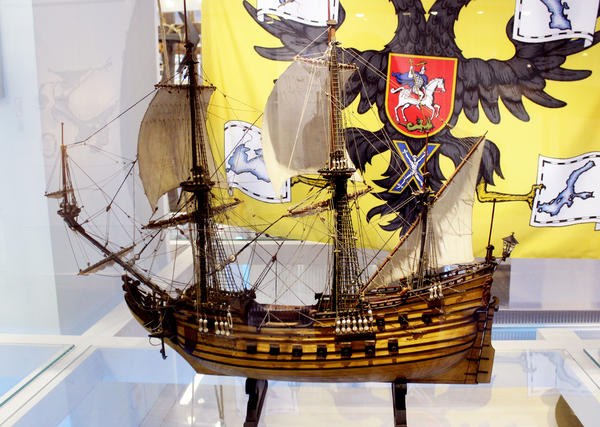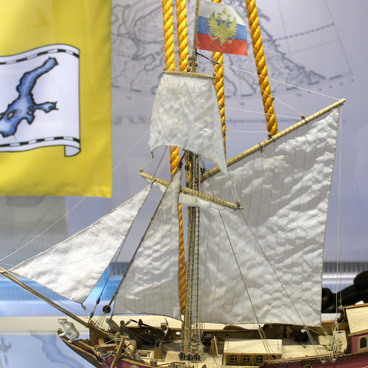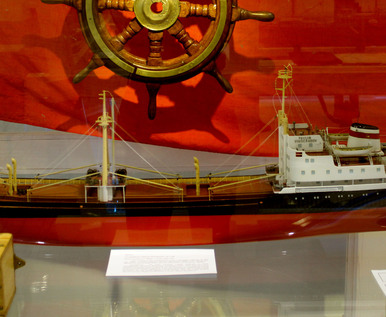Since the beginning of time Holland has been reckoned a seafaring nation. No wonder that it was the territory of the contemporary Netherlands where the most ancient dugout boat over 10 thousand years old was found. Fishery, trade, sea battles and, of course, piracy, called for continuous improvement of vessels by Dutchmen. As is argued by historians, in the late XV century the Netherlanders had more sailing vessels and boats in their possession than they had houses ashore. However, the neighboring states were watchful trying to push out the competitors from the North Sea waters. Hollanders were in need of a universal vessel – light, maneuverable, fast and capacious.
She came into being in 1595 at a shipyard in the town of Hoorn. It is assumed that the first fluyt was designed by shipwright Pieter Jansz Liorne, who made a number of constructional alterations in the design of classic Dutch ships. The proportions of fluyt were not standard – the length was more than four times the width and reached forty meters. Her narrow deck required the use of fewer masts but they were collapsible and taller. Narrower sails were used too, which could be raised and furled much faster. In general the hull resistance lowered thanks to innovations that made it possible for this sailing ship to pick up good speed and improve her maneuverability. Being simpler in handling, fluyt did not need a big crew which was reduced to 60-65 people. Accordingly, less water and provisions were required for long voyages.
The rigging of a classic fluyt in the XVII century was composed of three masts: the fore mast, main mast and mizzen mast. Her freight carrying capacity reached 400-500 tons and her draft fully laden did not exceed 3,5 meters. Thanks to good speed performance, capacity and simple handling, fluyts before long became popular not only in Holland but far outside it as well. All the more so as they were convenient not only for fishing but for fighting too, as well as for delivering cargoes at long distances.
Depending on their designation, fluyts had additional engineering specifics. For wood transportation the vessels called ’noortsvaerder’ were used. Their length often exceeded canonic forty meters thus making it possible to transport the whole tree trunks intended for construction of masts. The ‘straetvaerder’ type fluyts were engaged in grain and oil transportation; they had the best armament and quite often combined the functions of both war and merchant ships. For fishing, the ‘buis’ were used as a rule, with their convenient collapsible masts and spacious holds where barrels for salted fish were kept.
She came into being in 1595 at a shipyard in the town of Hoorn. It is assumed that the first fluyt was designed by shipwright Pieter Jansz Liorne, who made a number of constructional alterations in the design of classic Dutch ships. The proportions of fluyt were not standard – the length was more than four times the width and reached forty meters. Her narrow deck required the use of fewer masts but they were collapsible and taller. Narrower sails were used too, which could be raised and furled much faster. In general the hull resistance lowered thanks to innovations that made it possible for this sailing ship to pick up good speed and improve her maneuverability. Being simpler in handling, fluyt did not need a big crew which was reduced to 60-65 people. Accordingly, less water and provisions were required for long voyages.
The rigging of a classic fluyt in the XVII century was composed of three masts: the fore mast, main mast and mizzen mast. Her freight carrying capacity reached 400-500 tons and her draft fully laden did not exceed 3,5 meters. Thanks to good speed performance, capacity and simple handling, fluyts before long became popular not only in Holland but far outside it as well. All the more so as they were convenient not only for fishing but for fighting too, as well as for delivering cargoes at long distances.
Depending on their designation, fluyts had additional engineering specifics. For wood transportation the vessels called ’noortsvaerder’ were used. Their length often exceeded canonic forty meters thus making it possible to transport the whole tree trunks intended for construction of masts. The ‘straetvaerder’ type fluyts were engaged in grain and oil transportation; they had the best armament and quite often combined the functions of both war and merchant ships. For fishing, the ‘buis’ were used as a rule, with their convenient collapsible masts and spacious holds where barrels for salted fish were kept.



